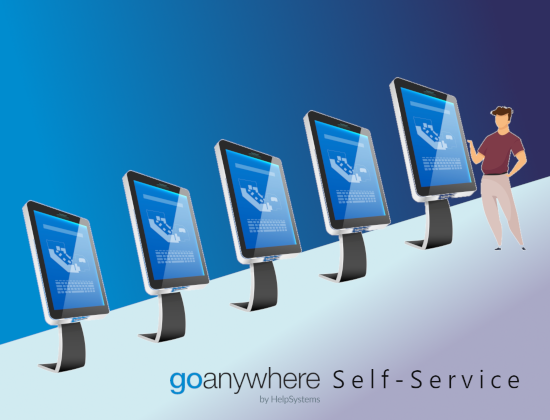
11 Jul 2022 Self-Service concept with GoAnywhere MFT
Before we dive into this topic, let’s have a quick look what Self-Service actually means.
“Self-service is the practice of serving oneself, usually when purchasing items. Common examples include … at buffet-style restaurants, where the customer serves their own plate of food from a large, central selection.”
(https://en.wikipedia.org/wiki/Self-service)
by Helder Valente
Using this example of the “buffet”, it is required for the master-chef to provide the central selection of food before you can start serving yourself. In this case, you might feel in the mood for two types of cooked meat, some fries and two sauces. You choose and serve yourself from what the central selection of food has to offer. Not more and not less! You can’t cook whatever you like, because the owner of the restaurant does not provide you with access to his kitchen.
So how can we translate this self-service concept to GoAnywhere MFT? Within the application, the Workflow Project Designer would be our kitchen. And if you allow everybody to do everything at any time, they would all have to be a chef in this “kitchen”. But there is a risk: too many chefs will ruin the quality of the dishes … and potentially the kitchen! This approach could already be explained as some sort of Self-Service, but maybe in a more “anarchy-style”.
Hence, that for a more “conventional” Self-Service, the admin users (respectively Dev-Ops users) will have to define the standard workflows templates first, before they can be made available to the restaurant as the “central selection” of your “buffet”. As soon as this fundamental decision has been finalised, you will have to find a way on how to present your “selection” at the “buffet”. Will you use “pots and pans” jumbled at the table, or do you want to present it in a more organised way. Like first the selection of “meat”, secondly the “side dishes” and then finish with the “sauces”?
If you interested to find out more about the “guided way” instead of the “jumbled- or anarchy-style”, then enjoy reading about the Demo-Project below, that will explain an interesting way on how to set up this concept with GoAnywhere MFT.
Demonstrating the concept
To demonstrate the “guided way” concept, our MFT experts within the BBES-group have developed a Demo-Project that describe the steps on how you can create your own “MFT Self-Service-Portal”, using the built-in features of GoAnywhere. It shows you how to setup and import with as limited manual effort as possible.
Our Project and Secure Forms templates have been created using a PostgreSQL Database in combination with GoAnywhere MFT version 6.8.6.
To be able to run our Demo-Project it is required to install the Add-on “GoAnywhere Command Connector” and you can’t use the internal Derby-DB. Also you need to have basic GoAnywhere skills, by an administrative user with “Product Administrator Role” and you need the following licenced features: Advanced Workflows and Secure Forms. Trail keys can be provided if you have not yet purchased these features.
With those of you that are interested, we can share more details and the templates that can be imported. But at high level, the steps to perform would be as follows:
Step 1 – Create a new Admin User:
Step 2 – Create a new Web-User in Domain Default (Domain ID = 1).
Step 3 – Create a new Database Resource pointing to your GoAnywhere DB.
Step 4 – Create a new “GoAnywhere Command Connector” pointing to your GoAnywhere MFT.
Step 5 – Create Project-Folder-Structure:
Step 6 – Import the Demo-Project:
Step 7 – Customise Project with the ProjectDesigner
Step 8 – Import the SecureForms template
Step 9 – Customise the SecureForms template
Using Self-Service-Portal
First conclude the described steps for the demo project. The creation and deployment of Resources, Projects, Users and more, can be automated by the use of available API’s and can be used for example by git-deployment-pipelines or similar. Alternatively, the build-in web based secure forms can be used to create a self-serviced environment. New interfaces could be requested and automated without manual intervention
Implementing this self-Service concept allows your development team or other resources outside of IT, to request and create file transfer flows without using the application interface. Business operations teams can build file transfer flows faster, without relying on IT and gain more agility internally while externally becoming easier to do business with. Through better process orchestration, business teams can leverage new and existing technologies and compose them into new service solutions and that too with minimal IT intervention.
If you are interested to find out more about how your organisation could implement the self-service concept with GoAnywhere, please don’t hesitate to reach out to us by email to sales@bluefinch.com. We are more than happy to share our knowledge and experiences.
